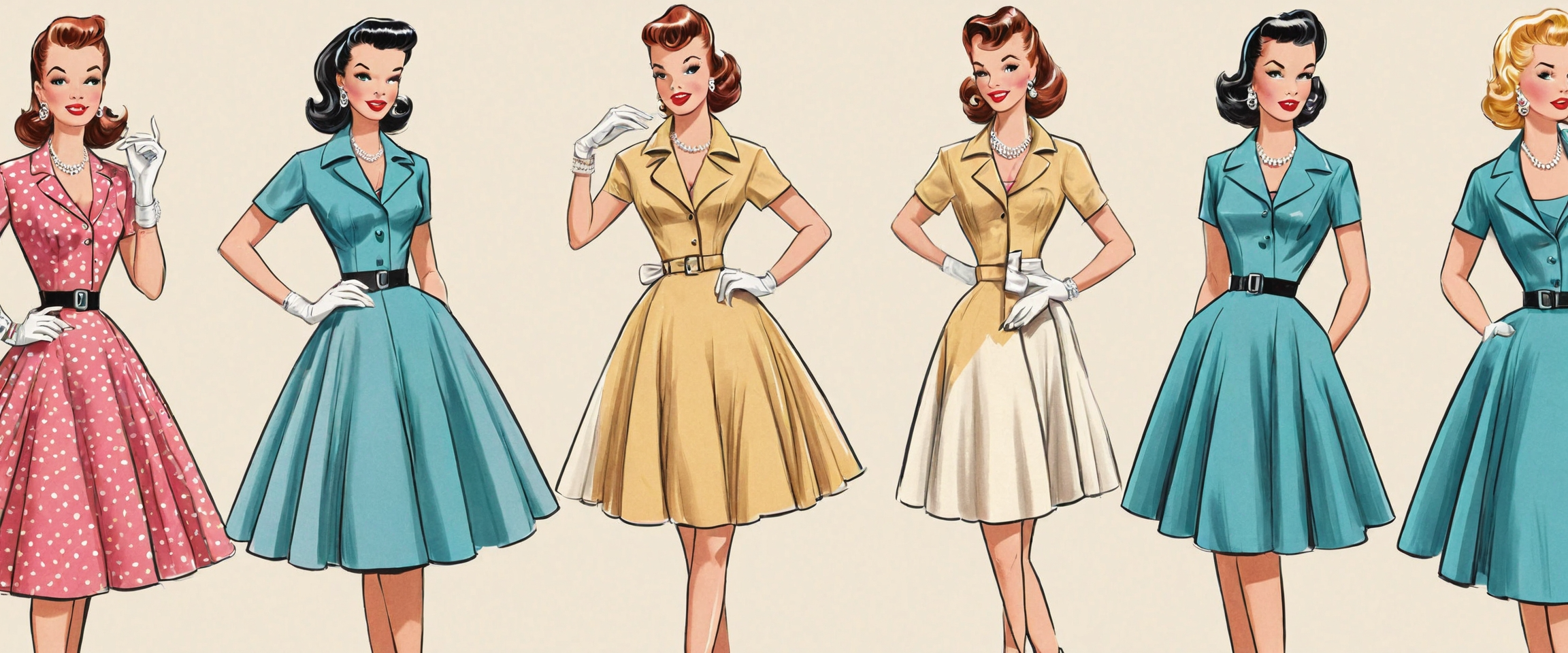The 1950s were a transformative decade in fashion history, characterised by an intoxicating blend of optimism, glamour, and conservatism. After the austerity of the 1940s wartime years, the world embraced a new era of prosperity, and nowhere was that more visible than in the clothing people wore. Fashion became a celebration of femininity, luxury, and self-expression, while still reinforcing traditional societal roles, especially for women.
Influences Behind 1950s Fashion
Post-War Optimism:
World War II had ended in 1945, and by the 1950s, economies in the West, especially in America, were booming. Materials that had been rationed during the war were now abundant. Fashion designers responded by creating styles that were indulgent, full-skirted, and rich in fabric. This era embraced extravagance as a symbol of freedom and prosperity.
The “New Look”:
Christian Dior‘s 1947 “New Look” (characterised by a cinched waist, full skirt, and accentuated bust) dominated the 1950s. Dior’s vision represented a departure from the utilitarian wartime fashion, emphasising a return to traditional femininity.
The Rise of Consumer Culture:
Mass production made fashionable clothing more accessible than ever before. Ready-to-wear collections surged in popularity, allowing everyday people to stay on-trend without the high costs of custom tailoring.
Hollywood’s Golden Age:
Film stars became global style icons. Actresses like Marilyn Monroe, Audrey Hepburn, and Grace Kelly influenced women’s fashion with their glamorous, yet relatable public images. Men looked to stars like Marlon Brando and James Dean, who redefined masculinity in fashion.
Key Garments and Styles of the 1950s
For Women:
- The Hourglass Silhouette: Thanks to Dior’s “New Look,” women’s fashion celebrated curves. Dresses and suits were designed to create an hourglass figure, with fitted bodices, nipped waists, and full skirts.
- Pencil Skirts and Wiggle Dresses: In contrast to the full-skirted look, the pencil skirt offered a sleek, body-hugging silhouette that was equally popular for daywear and cocktails.
- Poodle Skirts: A teenage craze, poodle skirts were wide, swingy skirts (often made of felt) with playful appliqué designs, most famously the poodle motif.
- Sweater Sets: Matching cardigans and pullovers, often worn with pearls, created a prim yet approachable look popular among young women and housewives.
- Capri Pants and Pedal Pushers: A casual alternative to skirts, these slim-cut trousers signaled a more relaxed, youthful side of women’s fashion.
- Gloves and Hats: No outfit was complete without the right accessories. Gloves, often wrist-length, were worn daily, and hats—from dainty pillboxes to wide-brimmed models—were an essential element of proper attire.
For Men:
- Grey Flannel Suits: The “man in the grey flannel suit” symbolised the ideal middle-class, corporate professional.
- Leather Jackets and Jeans: Thanks to rebels like James Dean and Marlon Brando, denim and leather symbolised youthful rebellion.
- Ivy League Style: Preppy fashion took off among young men, with clean-cut chinos, loafers, crewneck sweaters, and sports coats gaining popularity.
- Casual Shirts: Hawaiian shirts, bowling shirts, and other colourful casualwear also became acceptable weekend attire.
Key Figures in 1950s Fashion
- Christian Dior: His “New Look” was arguably the single most influential development in postwar fashion.
- Coco Chanel: After a hiatus during the war years, Chanel returned in the 1950s with her signature suits and simple, elegant designs that countered the opulence of Dior’s style.
- Hubert de Givenchy: His collaboration with Audrey Hepburn resulted in iconic looks that defined a new, slender, elegant silhouette.
- Marilyn Monroe: With her glamorous, sultry style, Monroe became a global symbol of sex appeal and Hollywood fashion.
- Grace Kelly: The epitome of grace and refinement, Kelly’s classic, clean fashion sense influenced millions and remains iconic today.
- James Dean: His simple, rugged style of jeans, white T-shirts, and leather jackets gave rise to the “bad boy” image that remains cool to this day.
Conclusion
The 1950s were a time when fashion was about reasserting gender roles, celebrating prosperity, and expressing optimism about the future. It was an era where femininity and masculinity were clearly defined but where youth culture began to slowly shift the landscape. Even today, echoes of the ’50s – full skirts, cat-eye sunglasses, denim jackets – continue to inspire designers and trendsetters worldwide.
Fashion in the 1950s wasn’t just about clothes – it was about reclaiming joy, reinventing identity, and setting the stage for the cultural revolutions of the decades that followed.

